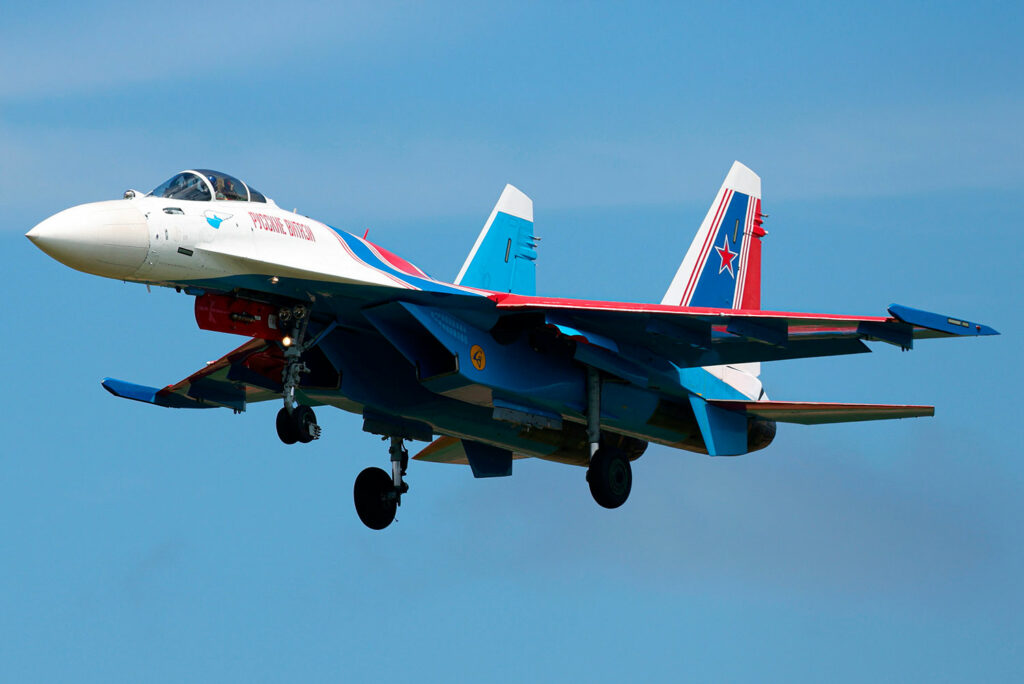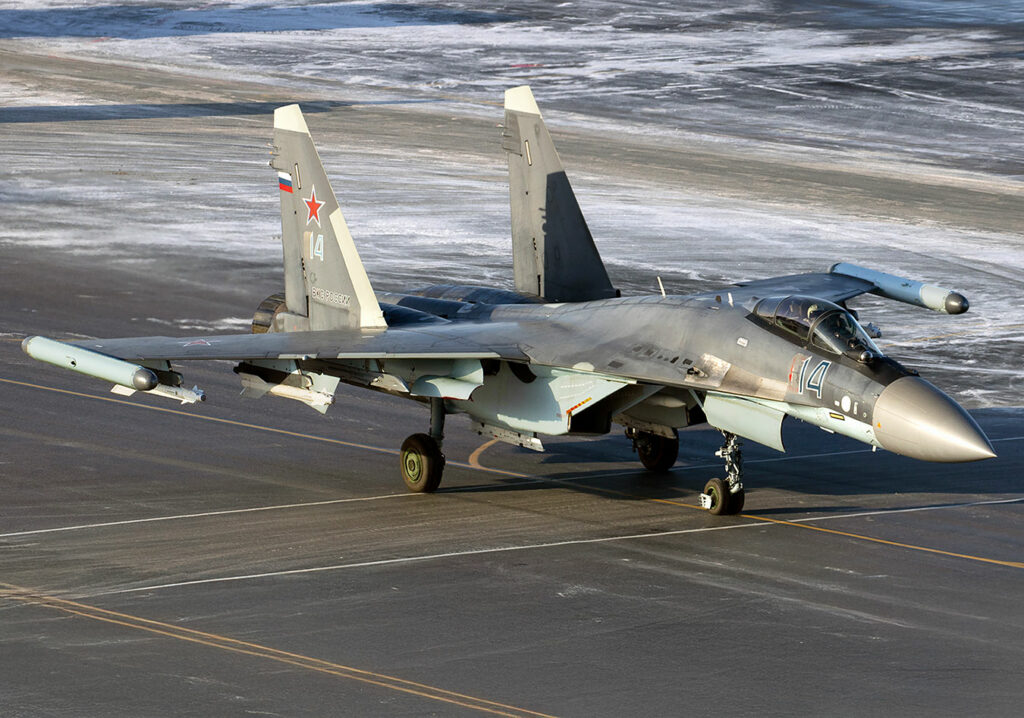The Sukhoi Su-35 is a Russian single-seat, twin-engine, supermaneuverable multirole fighter aircraft derived from the Su-27.
The Sukhoi Su-35, known by NATO as “Flanker-E,” is a Russian single-seat, twin-engine, supermaneuverable multirole fighter aircraft developed from the Su-27 air-defense fighter. Designed by the Sukhoi Design Bureau and manufactured by United Aircraft Corporation, the Su-35 features advanced avionics, enhanced engines, and improved aerodynamics. It is powered by two NPO Saturn AL-41F1S turbofan engines with thrust vectoring, enabling exceptional agility. The aircraft can reach speeds up to Mach 2.25 and has a range of approximately 2,200 miles (3,600 kilometers). Equipped with a 30mm GSh-30-1 cannon and capable of carrying up to 17,630 pounds (8,000 kilograms) of ordnance on 12 hardpoints, the Su-35 is versatile in engaging both aerial and ground targets. Its advanced radar and electronic warfare systems enhance situational awareness and survivability.

History of the Development of the Sukhoi Su-35 (Flanker-E / Super Flanker)
In the late 1980s, the Soviet Union sought to improve its air defense capabilities by enhancing the Su-27 fighter, which had entered service in 1985. The objective was to develop a more advanced variant capable of superior maneuverability, extended range, and multirole functionality. The Sukhoi Design Bureau initiated the Su-27M program, later designated as the Su-35, to address these requirements.
The Su-27M featured several modifications, including the addition of canard foreplanes for improved agility, a strengthened airframe to accommodate increased payloads, and advanced avionics systems. The first prototype, designated T10M-1, conducted its maiden flight on June 28, 1988. This marked a significant milestone in the aircraft’s development, demonstrating the feasibility of the enhancements over the original Su-27 design.
Following the dissolution of the Soviet Union in 1991, the program faced financial constraints, leading to limited production and testing. Despite these challenges, Sukhoi continued to refine the design, focusing on improving the aircraft’s multirole capabilities and export potential. The Su-35 designation was officially adopted to attract foreign interest, with the aircraft being showcased at various international air shows during the 1990s.
In the early 2000s, recognizing the need for a more advanced fighter to bridge the gap between existing fourth-generation aircraft and the forthcoming fifth-generation Su-57, Sukhoi embarked on developing an updated version of the Su-35. This iteration, known as the Su-35S, incorporated significant advancements, including new engines with thrust vectoring, a digital fly-by-wire control system, and an advanced radar with electronic scanning capabilities.
The Su-35S prototype first flew on February 19, 2008, marking the beginning of a new phase in the aircraft’s development. Extensive testing followed, leading to the Russian Ministry of Defense placing an order for 48 Su-35S fighters in 2009. Deliveries commenced in 2012, with the aircraft entering service with the Russian Aerospace Forces in 2014.
The NATO reporting name “Flanker-E” was assigned to the Su-35, following the convention of using the “Flanker” designation for Su-27 derivatives. The “E” suffix indicates an evolved version within the series. The Su-35 has since been recognized for its advanced capabilities, serving as a critical component of Russia’s air defense strategy and participating in various military operations.
Design of the Sukhoi Su-35 (Flanker-E / Super Flanker)
The Su-35’s design builds upon the Su-27 airframe, incorporating several enhancements to improve performance and versatility. The aircraft measures approximately 71 feet 10 inches (21.9 meters) in length, with a wingspan of 50 feet 2 inches (15.3 meters) and a height of 19 feet 4 inches (5.9 meters). The wing area is about 527 square feet (48.8 square meters), providing a balance between lift and maneuverability.
One of the notable design features is the absence of canard foreplanes, which were present in earlier Su-27M prototypes. Instead, the Su-35 utilizes a refined aerodynamic profile and thrust vectoring engines to achieve superior maneuverability. The airframe is constructed using a combination of aluminum alloys and titanium, offering strength while minimizing weight.
The cockpit is designed for a single pilot and features a glass cockpit layout with multiple multifunction displays (MFDs). The pilot operates the aircraft using a hands-on-throttle-and-stick (HOTAS) system, enhancing control during complex maneuvers. The ejection seat is the K-36D-3.5E, providing high-altitude and high-speed ejection capabilities.
The Su-35 is powered by two NPO Saturn AL-41F1S turbofan engines, each capable of producing approximately 31,900 pounds-force (142 kilonewtons) of thrust with afterburner. These engines feature thrust vectoring nozzles, allowing the aircraft to perform advanced maneuvers such as the Pugachev’s Cobra and the Kulbit. The engines are equipped with full authority digital engine control (FADEC) systems, optimizing performance and fuel efficiency.
The aircraft’s avionics suite includes the Irbis-E passive electronically scanned array (PESA) radar, capable of detecting and tracking multiple aerial and ground targets simultaneously. The radar can detect targets at ranges up to 250 miles (400 kilometers) and engage up to 30 targets at once, with the ability to simultaneously guide missiles to up to 8 targets. This capability enhances the Su-35’s situational awareness and combat effectiveness.
The Su-35 is equipped with a modern electronic warfare (EW) suite that includes radar jamming and spoofing systems to counter enemy air defenses. Infrared search and track (IRST) systems are integrated to detect and engage stealthy aircraft and low-visibility targets.
The airframe has reinforced landing gear and structures, allowing for operations from various types of airfields, including semi-prepared runways. Additionally, the aircraft features internal fuel tanks with a capacity of approximately 25,400 pounds (11,500 kilograms), providing substantial operational range without relying heavily on external fuel tanks.
Performance of the Sukhoi Su-35 (Flanker-E / Super Flanker)
The Su-35’s performance parameters place it among the most capable fourth-generation fighters in service. Its twin AL-41F1S turbofan engines provide a combined thrust of 63,800 pounds-force (284 kilonewtons), enabling exceptional power-to-weight ratios critical for air combat superiority.
Speed and Altitude
The Su-35 can achieve a maximum speed of Mach 2.25, equivalent to approximately 1,500 miles per hour (2,400 kilometers per hour) at high altitude. At low altitudes, its top speed is approximately 870 mph (1,400 km/h). The aircraft’s service ceiling is 59,100 feet (18,000 meters), allowing it to operate effectively in high-altitude engagements.
Range
The operational range is approximately 2,200 miles (3,600 kilometers) on internal fuel. With in-flight refueling, this can extend to over 3,400 miles (5,500 kilometers), making the Su-35 suitable for long-range strike and patrol missions.
Agility and Maneuverability
The Su-35’s supermaneuverability is a defining feature, facilitated by thrust vectoring engines and advanced aerodynamics. It can execute complex maneuvers such as the Pugachev’s Cobra and controlled flat spins, which provide an edge in close-range dogfights. These capabilities enhance the Su-35’s survivability by enabling it to evade enemy missiles and achieve superior positioning in aerial engagements.
Armament and Payload
The Su-35 is armed with a 30mm GSh-30-1 cannon with 150 rounds, suitable for close-range combat. It has 12 external hardpoints capable of carrying up to 17,630 pounds (8,000 kilograms) of ordnance. These include:
- Air-to-air missiles: R-77, R-73, and R-27
- Air-to-surface missiles: Kh-29, Kh-31, and Kh-59
- Anti-ship missiles: Kh-35 and Kh-31
- Guided bombs: KAB-500 and KAB-1500 series
Comparison with Competitors
When compared to Western aircraft like the F-22 Raptor and Eurofighter Typhoon, the Su-35 offers a unique combination of speed, range, and weapon load. While the F-22 excels in stealth and advanced sensors, the Su-35’s supermaneuverability and larger payload capacity provide it with advantages in certain scenarios, particularly in extended missions and combat flexibility.

Variants of the Sukhoi Su-35 (Flanker-E / Super Flanker)
The Su-35 has been developed in two primary variants:
- Su-35S: This is the production model developed for the Russian Air Force. It features the AL-41F1S engines, Irbis-E radar, and an advanced electronic warfare suite. The Su-35S emphasizes multirole capability, combining air superiority and ground-attack missions.
- Su-35 Export Variant: This version is tailored for international customers, with slight modifications to avionics and systems based on export restrictions and buyer requirements. Examples include deliveries to China and Egypt, with avionics configured to align with the buyer’s specifications.
Military Use and Combat of the Sukhoi Su-35 (Flanker-E / Super Flanker)
The Su-35 has seen extensive operational use, particularly by the Russian Aerospace Forces. It has been deployed in various roles, from air superiority missions to precision strikes.
Armament and Combat Systems
The Su-35’s arsenal includes the latest Russian air-to-air and air-to-ground munitions. Its GSh-30-1 cannon is effective for close-in dogfights, while its missile capabilities allow it to engage multiple targets at long range. The aircraft’s radar and electronic warfare systems enhance its survivability, enabling operations in highly contested environments.
Combat Deployments
The Su-35 was prominently deployed during Russia’s intervention in Syria starting in 2015. It performed air-to-ground strikes against militant targets, often carrying precision-guided bombs like the KAB-500S. The Su-35 also provided air cover for other Russian aircraft, demonstrating its air superiority capabilities.
In Ukraine, the Su-35 has been utilized for both air dominance and ground attack missions. Its advanced electronic warfare capabilities were crucial in countering Ukrainian air defenses, although it faced significant challenges due to modern air defense systems like the NASAMS and Patriot.
International Sales
The Su-35 has been exported to several countries, including China and Egypt. China procured 24 aircraft in 2015, primarily to enhance its air superiority capabilities. Egypt followed with an order for 24 Su-35s, aiming to modernize its air force. Potential customers like India and Indonesia have expressed interest, though political considerations have influenced procurement decisions.
Current Status
The Su-35 remains in active service with the Russian Aerospace Forces and other operators. Continuous upgrades to avionics and weapons ensure its relevance in modern combat scenarios. It is not a stealth platform but provides a cost-effective alternative for nations seeking advanced multirole capabilities without investing in fifth-generation aircraft.
Back to the Fighter Jet section.